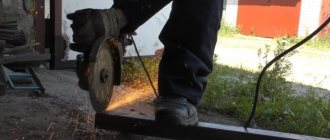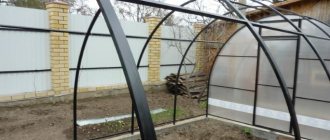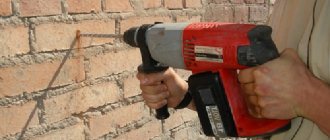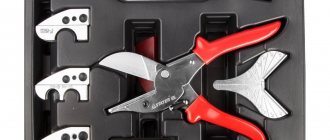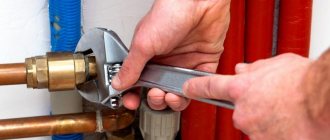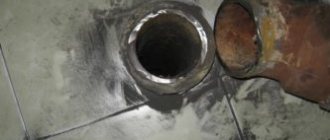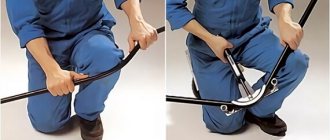← Prev. article Metal cutting: what is it, types of cutting Metal cutting is the marking of parts on a metal sheet, and not just marking, but placing them with the greatest economy in order to use the sheet with a minimum amount of waste. The less waste, the cheaper the part is. They can be completely avoided only with products of the correct geometric shape; shaped blanks, as a rule, have a large number of uneven lines and curves.
Track. article →Welding: what is it, types Welding is a permanent connection of two or more parts, obtained by heating them, plastic deformation, or both methods simultaneously. Most often, when people talk about welded joints, they mean metal, but other materials can also be welded: for example, plastic...
Date: 04/13/2020Author: MOP “Complex 1”
Track. article →Welding: what is it, types Welding is a permanent connection of two or more parts, obtained by heating them, plastic deformation, or both methods simultaneously. Most often, when people talk about welded joints, they mean metal, but other materials can also be welded: for example, plastic...
The article is relevant to the services: 3D plasma cutting of pipes
Rating: 51 votes
- 1. What is it?
- 2. Pipe cutting technologies
- Video
Tools used
A simple operation at first glance, cutting pipes in practice reveals many nuances and pitfalls. If not, just cut the tubes evenly:
- Thin-walled.
- Large diameter.
- With a bevel.
It is very important to choose the cutting method and special equipment suitable for each specific case. It is divided into individual, household and industrial
Required Tools
For individual use
They are used in households, private construction and small businesses. Deal with small and medium diameters (up to 250 mm) used in systems
- Water supply.
- Heating.
- Sewer.
- Ventilation.
Such tools include:
Cutters. Used to evenly cut polymer pipes up to 75 mm. To make an even and neat cut they have a gear mechanism. The workpiece is first clamped with a shelf clamp, which securely fixes it and prevents it from leaving the cutting line. Disc cutter. Suitable for ventilation and sewer polymer pipes with a diameter of up to 200 mm. The blade is not a secateur type, but in the form of a disk rolling along the surface of the workpiece. The cut is made in several turns. Not suitable for rolled metal-plastic, as it can crush the thin metal liner. Guillotine. The flat oblique knife moves in the guides and allows you to cut exactly the required length in one pass. It is available both with an electric drive, which provides greater productivity, and with a manual drive. Hacksaw for metal. A classic metalworking tool allows you to evenly cut a workpiece clamped in a vice.
When using, it is important to drive the saw smoothly, with constant force and without distortion. Burrs formed after using a hacksaw should be cleaned with a file. Angle grinder, angle grinder
In everyday life it is called “grinder”. This universal tool can handle any materials and diameters. In order to cut a pipe with a grinder, special abrasive cutting discs are used. Electric jigsaw. A very popular tool among home craftsmen, it can also cut pipes, but due to the flexible blade moving to the side, you can only dream of accuracy. Reciprocating saw. The instrument has not yet become widespread among Russian craftsmen. The adjustable stop of the saw and its powerful blade allow you to cut off rolled products even while suspended and close to the wall.
How to cut a pipe straight
To ensure an even cut from a general-purpose tool, special devices should be used to fix the workpiece. These can be templates, vices or miter boxes
In addition, it is very important to correctly mark the future cut and, while working, make sure that the cutting line does not go to the side
For industrial use
Such equipment is used in industries where the volume of work is large or large diameter pipes have to be cut. To cut straight, use:
- Lathe. Suitable for high-precision cutting of workpieces, chamfering, making ledges, diameter transitions and other shaped processing. Allows you to lathe and cut threads, both internal and external. The length of the part is limited by the overhang of the machine head. Diameter - overhang of the chuck jaws.
- Tape machines. They are used to cut a large diameter pipe without removing it from a trench or collector point. They also work on deformed products.
- Disc cutting machines. Highly automated installation with a pendulum saw and a workpiece feeding mechanism. Often included in the production line, it is used for high-performance cutting of rolled products into equal pieces.
- Manual disk installations. Mobile equipment is used to cut the rolled products exactly right at the installation site. Equipped with a multifunctional clamp that allows you to securely fix products of different diameters and cut them evenly without damaging the edges. The rotating work table allows you to cut smoothly at any angle. The most advanced models are equipped with an orbital welding system. This allows you not only to cut, but also to connect segments.
CNC Pipe Cutting Machine
Decorative solutions
A plastic corner is the most common and affordable option for decorative finishing of various joints in the bathroom. The use of such a corner helps to hide all aesthetic defects that arise as a result of rough sealing of seams. The corner can close gaps up to 3 cm wide. It is recommended to fasten the baseboard using transparent sanitary silicone. Silicone is an excellent adhesive, provides additional sealing, and also contains antifungal additives, which is necessary when finishing a bathroom.
Border tape is the easiest and fastest way to close a gap up to 3 cm. The tape is a strip of polyethylene with an adhesive base. To glue it, you just need to degrease the work surface, measure and cut the required piece and attach it, pressing with your fingers, to the gap. Border tape without an adhesive layer is installed using silicone.
Experts recommend purchasing border tape without an adhesive base and installing it using silicone. This way it will last longer.
You can fill the gap with tiles. It is better to use tiles left over after tiling the walls. If there are no tiles left after the renovation, you can purchase several pieces of white tiles of such a size that a minimum of trimming is required. If the bathtub is white, the tiles will blend in with it and the borders will be almost invisible.
Sometimes when decorating walls with tiles, craftsmen use a decorative ceramic border. The same border can also be used to decorate the joints. Attach it to the surface using waterproof glue or liquid nails.
Application of thermal methods
In addition to mechanical methods, thermal methods are often used, where welding or cutting machines are used as tools. For example, an autogenous gas cutter or a conventional welding machine (DC/AC).
With the help of such machines, thick-walled metal pipes can be cut. However, it is extremely difficult to obtain a perfectly even, high-quality cut using electric welding or gas autogen.
Cutting technology using electric welding and autogen is widespread everywhere. The technique does not provide high cutting accuracy, but when installing pipes this factor is often not decisive
Cutting technology using electric welding and autogen is widespread everywhere. The technique does not provide high cutting accuracy, but when installing pipes this factor is often not decisive
Typically, after thermal cutting, products undergo additional processing. The cut line is aligned and the required angle values are adjusted. This approach is economically unprofitable, as it is accompanied by additional costs for mechanical processing.
As a rule, thermal cutting techniques are used in industrial production conditions. True, housing and communal services also often resort to this technique.
Thermal cutting is also used to work with plastic materials. There are devices - thermal guillotines. The sharp thin blade of such devices is heated to a high temperature, after which the cut is performed.
Thermal guillotines support cutting at an angle, and this is their advantage. However, these devices cannot be used to work with materials that are more rigid than polyvinyl chloride, wood, or chipboards.
To cut metal-plastic pipes, you need pipe cutters that can evenly divide products with a multilayer structure into parts. Our recommended article is devoted to their varieties and methods of application.
Laser equipment
Laser cutting of a profile pipe will be one of the highest quality and less labor-intensive compared to mechanical processing options. This is professional equipment that gives an absolutely even cut, which no mechanical tool is capable of. Thanks to laser equipment, you can easily make cuts at an angle of 45 degrees, which is very difficult to achieve when using a cutter or grinder.
Pipe profile cutting to size:
- The maximum thickness of the metal layer is 6.5 mm;
- Maximum part radius – 80 mm;
- The maximum length of the material is 3-3.5 m.
The photo shows a laser machine that automatically cuts metal parts.
Kinds
Varieties of pipe cutters are classified depending on the objects being cut and the characteristics of the cutting element. Accordingly, the following types of tools are distinguished:
- The cutter cuts pipes up to 100 mm in diameter. Suitable not only for steel, but also for plastic pipes, Has several steel discs.
The chain one is distinguished by the fact that it can cut pipes made of dense materials (cast iron, concrete, ceramics), since it has a mechanism for tightly fixing the cutting object, made on the basis of a conventional chain and rotary levers.
Video instructions: how to work with a pipe cutter.
- The roller is equipped with cutting rollers (from 1 to 3) and guide elements, and the diameter of the pipes that it can cut directly depends on the number of rollers: a device with 1 roller cuts pipes up to 50 mm, and with 3 rollers – up to 100 mm and even more .
The telescopic one has a carriage, roller and guides that can optimally fix the pipe depending on the required cutting angle. It copes well with cutting thick pipes or made of durable materials, since due to the configuration it can create strong pressure on the surface of the cutting object.
The ratchet pipe cutter is portable and can cut thin pipes. Its design is the simplest among devices of this class - 2 handles and a cutting blade.
Electric equipped with an electric motor
due to which the worker’s efforts in cutting the pipe are minimal - it is only important to configure the tool correctly, he will do the rest of the work almost independently
At the same time, it is a universal tool - it cuts pipes of any diameter and from any material. Application is limited only by engine power. However, such a pipe cutter also has a significant drawback - it will be inconvenient to use in hard-to-reach areas of work (for example, sewer pipes).
With its help, you can not only carry out mechanical cutting of pipes, but also carry out work on their trimming, chamfering with blunting, as well as from the outer surface of the pipe.
Video overview of one of the models
Guillotine got its name because of the design of the cutting mechanism. Its knife makes a perpendicular cut in pipes of small diameters (up to 30 mm). The pipe is fixed in the frame, and the screw pushes the guillotine and makes a clear cut at an angle of 9 degrees. The tool is suitable for cutting pipes of different thicknesses and structures (single-layer, multi-layer, reinforced).
A pneumatic pipe cutter is driven by rarefied air pressure. This device is used in production for cutting pipes with very large diameters (up to 1500 mm). At the same time, it copes well with cutting dense materials (cast iron) and light plastic.
Orbital pipe cutters are designed not only for mechanical cutting of pipes, but also for chamfering thin-walled pipes. For this purpose, they are equipped with special chamfer cutters.
Often, add-ons are offered for various types of pipe cutters to ensure the safest conditions for working with pipes. Thus, using the quick crimping mechanism, you can quickly secure large pipes in the device without using a special screw. The pipe cutter can also be equipped with additional removable cutting elements designed for pipes of various thicknesses, and rollers that move the device around the pipe.
Cutting pipe at an angle of 45 and 90 degrees
If you need to cut a pipe at an angle of 45 degrees, which is often required when laying water and heating pipes. Often steel and cast iron pipes that have a cylindrical shape are used. In installation work, rectangular or profile pipes are used. However, you should cut the pipe correctly with a grinder so that you can easily connect it later. Therefore, you should carefully mark the pipe.
Some craftsmen try to mark the cutting area using a tape measure, but we warn you that the result will most likely be negative. And for a positive result, consider the following recommendation from professionals.
Take a sheet of paper or cardboard, preferably A4, fold it diagonally and wrap it around the pipe where you plan to make an even cut. The edges of the paper must be absolutely aligned with each other. And the side of the paper that is closer to the end of the pipe was perpendicular to the axis. Then mark a cutting line in a circle.
If you need to cut exactly at an angle of 90 degrees, then solve the problem quickly using paper or masking tape. Wrap it around the pipe so that the ends match. Make an even mark and saw off.
How to cut a profile pipe evenly?
Craftsmen advise using a square when cutting a profile pipe. To do this, apply the square to the sides one by one, and turn and apply marks with smooth movements. After the steps, secure the pipe and cut. Prepare yourself a template that will be useful in the future and will save time. It is better to carry out the action with a grinder, so the cut will be smoother.
How to cut a cast iron pipe?
When working with cast iron pipe, keep in mind that it is a fragile material. Therefore, we will find a way to cut such metal without damage.
Before starting work, make notes for the cut, as you would when working with steel pipes. Place a wooden beam for support. Run a grinder around the circumference of the pipe, making small cuts. Then take the chisels, insert them into the groove and hit them hard with a hammer. Please note that Bakelite-based cutting discs are used to cut cast iron pipes.
If you don’t have a grinder at hand to cut a cast-iron sewer pipe or other purposes, use a hacksaw, chisels or special pipe cutters.
How to cut a gas pipe?
Cutting a gas pipe is a dangerous action, so it is best to leave it to professionals. But if you are confident in your abilities, then use a grinder, welding, hacksaw, or gas welding to cut metal.
Trimming instructions:
- Before work, turn off the gas supply riser. Then release the rest of the gas from the pipe. To do this, light the gas in the burners and wait for it to go out.
- After these steps, cut. Using a welding method, the metal base burns when exposed to high temperature. The result is fast and effective. But remember that cutting or rooting gas pipes again requires experience.
Methods for cutting large diameter pipes
For cutting large diameter pipes, such as sewer pipes, there are a number of reliable tools available. Next, let's look at some of them in detail:
The grinder is an inexpensive and accessible option, but it is considered not the safest when working with such materials. If you decide to use this method, be careful and use protective equipment. A roller machine (pipe cutter) is a tool adapted for such manipulations. The device is attached and material removal begins. The clamping force is adjusted using mechanical devices
It is important to note that machine models differ in shape, so before use, consider the size relationship with the pipe. Gas cutting is the most popular option for cutting larger diameter pipes and sheet metal. The cut occurs due to the action of a high intensity flame, the metal melts and leaves the cut area with a gas flow
This method is convenient and effective.
How to cut a pipe lengthwise correctly?
A quick way to cut a pipe lengthwise using a grinder:
Pay main attention to the markings. For this case, use painting thread, which is widely used when marking walls.
Before starting work, secure the pipe and, using small movements, carefully saw the pipe. It’s better not to rush, but delicately and slowly process the parts of the pipe, so that the cutting disc does not jump off the marking lines. Remember safety precautions.
How to cut thin-walled pipes?
Thin-walled pipes are made of non-ferrous metals: aluminum, copper. Such work should be done delicately, as there is a high probability of deformation of the material. For cutting, fillers such as sand are used. Actions can be carried out using a grinder or a special machine.
Precision cutting devices
Among branded devices that could be used in everyday life to make cuts at an angle, you can pay attention to Italian-made equipment. Mini Cut band saw from - a small-sized device with manual clamping, for working not only with pipes, but also angles, rods, profile elements
The Mini Cut band saw is a small-sized device with manual clamping, for working not only with pipes, but also with angles, rods, and profile elements.
The machine supports setting the cutting angle from 0 to 45º. The procedure is carried out using a tape at a speed of 45 reciprocating movements per minute. The device is equipped with a 370 W electric motor, which is powered from a household network. The maximum permissible diameter of a round pipe to be cut is 65 mm.
On an industrial scale, numerous installations with electromechanical and electrical drives have been developed for pipe cutting. Technically sophisticated devices allow high-precision thermal, oxygen and plasma cutting:
Industrial models (using the example of BSM)
There are special machines for industrial use to perform precise miter cutting operations. A good example: devices produced under the BSM brand. The machine manufacturer is the German company Rexinger.
True, the BSM series machines are designed exclusively for working with polypropylene pipes of fairly large diameters. Processing of products such as PP, PVC, PE, PVDF is supported.
Industrial machine for cutting pipe products made of polymers. Designed to work with large diameter products, but has equipment for processing pipes from 50 mm. The machine provides cutting in a wide range of angles
The cutting tool of the machine is a band saw, thanks to which cuts are made at angles from 0 to 67.5º. The accuracy of the process is ensured by a laser cutting recognizer.
Despite the configuration of the device for large-diameter products, you can use a special table, which can also be used to successfully cut pipes of small diameters (50 - 200 mm), which are easier to cut using a pipe cutter. A wide range of BSM devices is produced.
Abrasive disc machine
In fact, this is the same grinder, which is simply fixed in a special frame for convenience. This tool is quite dangerous, but allows cutting at an angle of 90 or 45 degrees. Before using such a device, you need to take into account several nuances, otherwise you may get injured during operation:
- The machine must be well fixed on a horizontal surface;
- Cutting a profile pipe should only be done with glasses or a special mask;
- The movement of the tool itself must coincide with the rotation of the metal disk;
- Before work, the metal pipe must be securely secured in a vice.
Working with an angle grinder is quite difficult even for an experienced craftsman, so do not take up the tool if you are hearing about it for the first time. The cutting of metal parts is demonstrated in more detail in the video.
Features of cutting at an angle of 45 degrees
Cutting a profile pipe at an angle of 45 degrees poses some difficulties. After all, with manual marking, large errors can be made, which is why during the assembly process the elements may not fit together. To cope with the problem, it is best to make a small template from a part with the same cross-section.
Creating a template:
- Using a protractor, measure a 45-degree angle on a small piece of pipe;
- Using a machine with a grinder, make a cut and sand the edges of the workpiece;
- Now insert the profile with a smaller diameter into the finished template;
- Make markings using a homemade protractor.
Cutting a profile pipe at an angle can be carried out with tools for both thermal and mechanical processing of parts.
Conclusion
Fireless cutting of metal parts involves the use of tools that often do not give a very clean cut. After work, the edge of the part must be sanded to remove all burrs. Equipment for thermal cutting does not have this drawback, but it is used mainly in manufacturing enterprises.
In everyday life, we are constantly faced with the need to lay pipelines from various materials, be it water supply, sewerage, heating, installation of cable ducts, or even the construction of frame structures in a house or country house. This article will tell you how to evenly cut a pipe for certain purposes, if you do all the work yourself, that is, it provides detailed instructions for all technological operations. In addition, let's talk about the variety of tools for amateur or industrial use.
Hacksaw machine
This tool consists of a handle, a mobile frame, a cutter and an adjustment screw. Before cutting, the product is secured using a vice and then cut. A mechanical machine for cutting profile pipes is quite convenient to use, but has several disadvantages:
- The cutter may become very hot during operation;
- Mechanical cutting takes a lot of time;
- The edge of the cut pipe will have burrs that will have to be sanded down.
Cutting pipes: video instructions
In the process of manufacturing and installation of pipe systems, you can often encounter the need to have certain sections of pipes - cutting products. It is not easy to make a fairly even cut without burrs. It is proposed to study some basic methods and auxiliary tools for the process of cutting metal workpieces, both at a certain angle and perpendicularly.
Basic pipe cutting methods
Cutting metal parts with a rectangular cross-section depends on the special tool available. Cutting products can be done using the following equipment:
The first two devices are designed for mechanical processing of metal. A gas-powered installation is used for thermal cutting of parts.
Application of hacksaw machine
This installation includes a handle, a mobile frame, an adjusting screw and the cutter itself. Before cutting, the part must be secured in a vice, then the cut must be made. The machine for machining metal parts is easy to use.
But there are such disadvantages:
- High overheating of the cutting mechanism during operation is possible;
- A huge amount of time is wasted;
- As a result of pruning in this way, it is necessary to remove the burrs that always form.
Using an abrasive disc
In other words, this method is carried out by an ordinary angle grinder, previously fixed in a special frame for safety purposes. The advantage of this method is the ability to make cuts at angles equal to 450 and 900. Such a device is not safe in terms of injuries.
In order to ensure the safety of the work process, in this case the following safety rules must be followed: 1. The installation with the profile must be rigidly fixed on a horizontal plane;2. The process of cutting a profile part should be carried out only with the use of personal protective equipment - glasses, special masks;3. The movement of the cutting tool must coincide with the rotation of the disk;4. The profile pipe must be securely fixed in a machine vise.
Cutting profile products using a laser is one of the most reliable and high-quality, as well as less dangerous and complex in contrast to mechanical methods. This professional equipment makes the cuts perfectly smooth compared to mechanical tools. Mechanisms using a laser beam easily make cuts at an angle of 450, in contrast to the labor-intensive processing of workpieces with the aforementioned abrasive discs with a grinder and hacksaws.
Basic cutting methods
The method for cutting metal products with a square cross-section largely depends on the type of device chosen. Therefore, we list the types of tools with which the work can be done:
- Hacksaw machine;
- Bulgarian with a frame;
- Gas flame and laser installation;
The first two types of tools involve mechanical cutting of products, while gas-flame and laser installations involve thermal cutting. Let's look at each device for cutting metal products in more detail.
How to properly cut pipes from different metals
Accurate cutting and trimming of pipes depends not only on well-executed markings. The material is also of great importance - metal of different thicknesses and hardness is cut with different forces and side effects. To properly cut a cast iron pipe, it should not be sawed all the way through. Cast iron is a brittle metal, so several cuts are usually made, and then a specialist knocks a piece out of them with one precise blow of a chisel.
To work with thin-walled pipes, you will have to very accurately check the position of the grinder. In this case, the master must choose the right one. In industrial settings, special pipe cutters, gas cutting machines and welding machines can be used to perform the same tasks.
Safety when cutting a gas pipe
When working with gas pipes connected to the mains, it is important to follow safety precautions. First turn off the gas supply valve, then make sure that there is nothing in the pipe
To do this, just open the stove burners and light the gas - when it runs out, the flame goes out.
How to cut a cast iron pipe
If the pipe is made of cast iron, then in order to cut it smoothly you will have to apply certain knowledge. The fact is that this material is characterized by high fragility, which means that before cutting such a pipe, you need to determine an algorithm of actions.
- We mark in the same way as steel pipes.
- At the cutting site, you need to place a wooden beam as a support.
- Next you need to make a cut of a few millimeters around the entire circumference.
- After this, a chisel is inserted into the groove and a sharp and strong blow must be applied with a hammer.
As a result, it will split along the line, forming a fairly even cut area, which can be further processed if necessary.
VIEW Pipe cutter for steel pipes on AliExpress →
